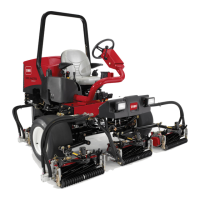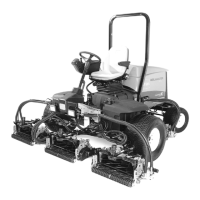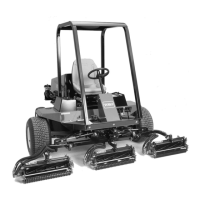Height-of-Cut Adjustment (Floating Cutting Unit)
Overview of Procedure:
1. Adjust reel to bedknife contact
2. Level rear roller to reel
3. Final height-of-cut adjustment using gauge bar.
STEP 1 - Adjust Reel to Bedknife Contact
A. Adjust reel to bedknife contact on all cutting units.
(Re
fer to Adjusting Reel To Bedknife Contact).
STEP 2 - Level Rear Roller to Reel
B. Start engine and lower the cutting units onto a flat
sur
face such as a piece of 3/4" or 1 “ plywood (at
least 20" x 30" in size). Stop engine and remove key
from switch. Lock cutting units in the fixed position,
by loosening the jam nut on lockout pin (Fig. 6) and
screwing pin into hole in pivot arm (Fig. 7). Tighten
Figure 6
Cutting Unit Float Position
1. Lockouts 2. Jam nut
nut to secure lockout. Raise the front rollers up so
they do not contact the flat surface.
C. Insert a piece of bar stock 25" - 28" (70 cm) long
(Fig. 8), and approximately 1/8" (3 mm) thicker than
the desired height-of-cut, under the reel and up
against the bedknife cutting edge (Fig. 8). The reel
(not bedknife) must contact the bar stock along its
full length.
NOTE: Using a bar 1 /8" (3 mm) thicker than height-of-
cut
provides proper bedknife attitude (heeled “up” in
back) required for excellent low height-of-cut perform-
ance.
D. Loosen rear roller jam nuts and adjusting knobs
and push roller down against flat surface. At this
point the reel should contacting the bar stock and the
rear roll contacting the flat surface. Contact should
Figure 7
Cu
tting Unit Fixed Position
1. Lockout pin 2. Jam nut
exist along the entire length of the reel a rear roller.
Tighten rear roller adjustme knobs and jam nuts.
Recheck to be sure roller and reel are both still
making contact after jam nuts have been tightened.
Check roll contact by trying to slide paper between
the roller and the flat surface.
E. Rear roller is now leveled to the reel.
Figure 8
Leveling Rear Roller to Reel
Adjustments Page 7 - 6 Reelmaster
®
335-D

